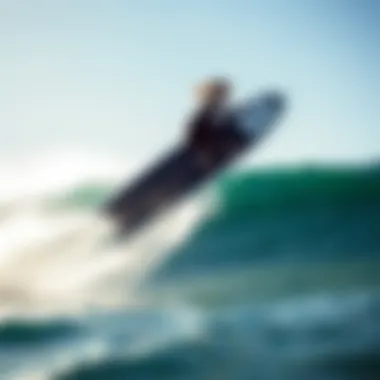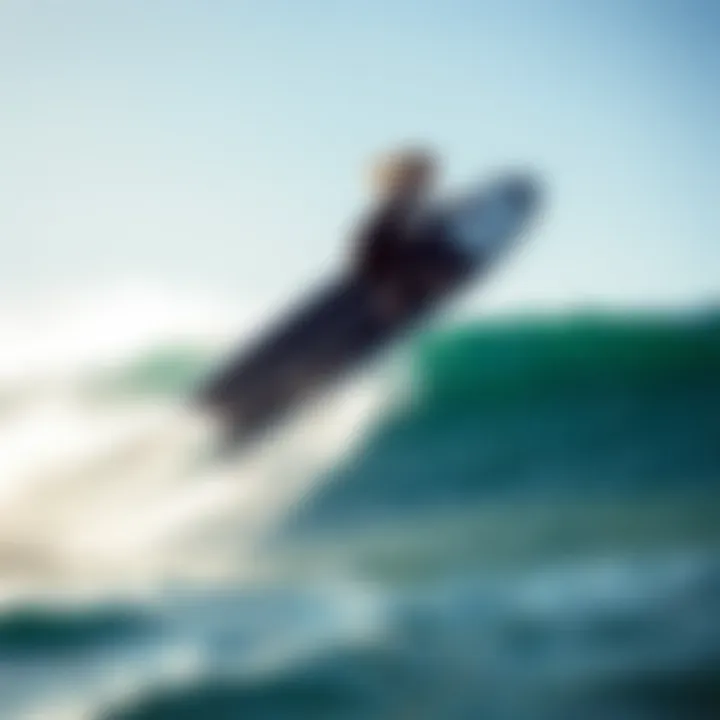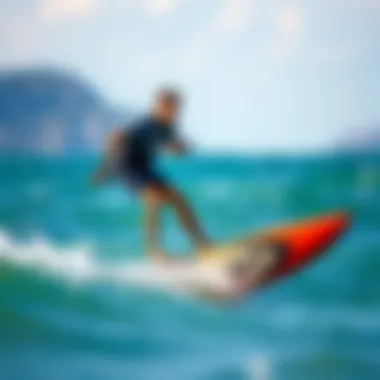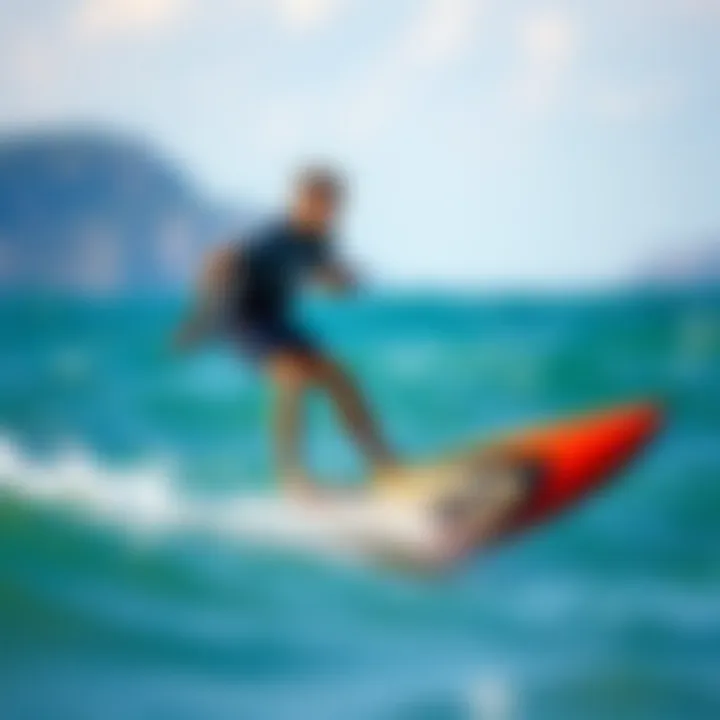Exploring Hydrofoiling Surfboards: The Ultimate Guide


Intro
In the ever-evolving world of water sports, hydrofoiling surfboards have emerged as a game-changer. The adrenaline-infused sensation of gliding above the surface is something every beach lover has pondered. But what exactly makes these boards so special? This guide aims to provide a thoughtful examination of hydrofoiling, pulling back the curtain on its engineering wonders while also breaking down its appeal to riders of all experience levels.
As water sports regain their splash in the spotlight, more surfers are taking notice of the unique characteristics of hydrofoil boards. You might be asking, why should I swap my traditional surfboard for one equipped with a hydrofoil?\nAfter all, the motivation to experiment usually comes from a desire to improve performance and broaden one's skills on the water.
This article will discuss various aspects of hydrofoiling surfboards—from concepts like how they function, the gear and equipment necessary for both beginners and pros, to techniques that will have you catching waves like a seasoned rider. Buckle up as we explore how hydrodynamics transforms your time on the water into something extraordinary.
Understanding Hydrofoiling
Hydrofoiling has rapidly gained traction within the water sports community, igniting curiosity among kiteboarders and outdoor enthusiasts. It represents not just a new way to surf, but a revolution in the way we engage with water. This section aims to shed light on what hydrofoiling truly is and why grasping its fundamentals is pivotal for anyone looking to ride the waves—or the air, as it might seem.
In essence, hydrofoiling allows surfers to glide above the water's surface, reducing drag and creating a sensation akin to flying. This transformation from merely skimming the water to ascending provides not only speed but also unique experiences that traditional surfing cannot replicate. Enthusiasts find themselves captivated as they harness the elements, carving through swell with a newfound sense of freedom. Understanding this novel approach enriches one's appreciation of the sport and highlights its growing significance in contemporary surfing culture.
The Concept of Hydrofoiling
Hydrofoiling can be described as using a foil—a submerged wing—to lift a surfboard above the water when sufficient speed is reached. By doing so, it allows the rider to experience a different type of flow, all while minimizing the turbulent forces of the water. Imagine it as riding a magic carpet that's held above the waves, where balance and timing play essential roles. This concept has deep roots, tracing back to the engineering marvels of aviation where similar principles allow aircraft to soar.
Looking at it closer, a hydrofoil consists of two main parts: the mast, which supports the foil above the water, and the actual foil, shaped much like an airplane wing. The interplay between lift and drag becomes crucial, allowing surfers to elevate themselves and experience smooth rides, even in less-than-ideal conditions. This adaptability marks hydrofoiling as an exciting addition to the repertoire of surf-related activities, enticing many to try their hand at it.
How Hydrofoils Work
The mechanics of hydrofoils blend physics and activity in a way that’s fascinating for surfers and engineers alike. Once a rider gains momentum, usually aided by paddles or a motor, the downward pressure on the foil creates lift. In simple terms, the foil spins through the water, generating upward forces which counteract gravity. For most beginners, getting comfortable with this sensation can feel like unleashing a tiger from a cage.
- Lift Generation: When the water flows over the foil, its specific shape creates differences in pressure, helping the board to rise.
- Speed Threshold: Achieving the necessary speed is crucial for lift-off. It’s a bit like pushing a heavy cart; you need a good shove to get it moving.
- Weight Distribution: Riders must juggle their weight on the board, a bit like balancing on a seesaw. Small adjustments in posture can lead to big results in how smoothly the ride goes.
Components of a Hydrofoiling Surfboard
The construction of a hydrofoiling surfboard comprises several integral elements that come together to create a thrilling riding experience. Understanding these components is crucial not just for enthusiasts but also for beginners looking to dive into this electric sport. Each part contributes to performance, usability, and overall enjoyment, making them significant in determining the right fit for individual riders.
Board Design and Material
A hydrofoiling board is distinctly different from a conventional surfboard. Its design is typically flatter, allowing for easier lift off the water's surface. The size, shape, and thickness of the board affects stability and buoyancy. When selecting a board, material also playes a critical role. Boards crafted from lightweight materials like carbon fiber or epoxy are common, as they enhance maneuverability while reducing weight.
Moreover, the weight distribution can affect how the board performs in the water. For instance, a heavier board may offer more stability, but it might sacrifice speed and responsiveness. Therefore, considering the right balance of sturdiness and lightness is key.
"Choosing the right board is like finding a comfortable pair of shoes; it’s about how it feels when you ride it."
Foils: Types and Configurations
The foil setup is the cornerstone of any hydrofoiling system. Generally, foils are comprised of wings and masts, and their configurations can significantly impact riding experience. There are two main types of wings: front and rear. Front wings are larger and aid in lift, while the smaller rear wings help with control and stability.
Mast length also matters; longer masts can offer higher lifts but may compromise stability, especially for beginners. Riders often find themselves weighing the pros and cons of different setups—some may prefer a bigger, more forgiving wing for easier lifts, while others could lean towards a smaller setup for increased agility and performance.
Fins and Stability
Fins may seem like minor components during rides, yet they can substantially influence maneuverability and tracking in the water. The right fin setup can enhance how the board holds a line, especially in choppy conditions. Some hydrofoiling boards come equipped with removable fins, allowing riders to customize their setups based on specific conditions or rider skill levels.
Laterally, stability is often achieved through a combination of the board's design and the foil configuration. A wider tail can offer greater lateral stability, making it easier to maintain balance during turns. Riders should consider their own skill level; beginners may find boards with greater stability more forgiving than those geared toward advanced maneuvers.
In summary, the components of a hydrofoiling surfboard each serve unique functions, catering to the diverse needs of different riders. Selecting the right combination of board design, foil configuration, and fin setup will greatly enhance the hydrofoiling experience, ensuring both performance and enjoyment on the water.


Advantages of Hydrofoiling
When it comes to riding the waves, hydrofoiling surfboards present an array of advantages that can elevate both the performance and enjoyment of the sport. Hydrofoiling—a technique allowing surfers to ride above the water's surface—has become a game-changer in the world of water sports. Understanding the intrinsic benefits can help enthusiasts make a more informed decision about integrating this innovative technology into their surfing repertoire.
Increased Speed and Performance
One of the key attributes of hydrofoiling surfboards is their remarkable speed and performance. Unlike traditional surfboards that rely solely on the force of the waves to propel forward, hydrofoils utilize hydrodynamics to lift the board off the water. This lift significantly reduces drag, allowing surfers to reach higher speeds with less effort. With a hydrofoil, the surfer can maintain momentum even when the wave's energy dissipates, making it possible to ride swells that would normally be unrideable on a standard surfboard.
Many surfers report a sensation akin to flying—gliding effortlessly above the water, completely disconnected from the turbulence below. This unique experience not only enhances thrill but also feels liberating. Surfers can link smaller waves together seamlessly, extending their ride time and making the most of a session, which is particularly beneficial in locations where waves are inconsistent or fickle.
Reduced Drag and Improved Efficiency
Hydrofoiling surfboards excel in reducing drag and improving efficiency on the water. The design of the hydrofoil creates a lift that acts in direct opposition to gravity, elevating the board and rider above the surface. As a result, this setup reduces friction significantly—a well-tuned hydrofoil can glide over water with minimal effort.
This streamlined experience also means that less energy is required to keep moving, ultimately providing the rider with a more enjoyable surf session. Less fatigue translates to longer rides, which is a substantial benefit for those who love to spend hours on the water. Additionally, it enables surfers to conserve energy, pick up speed, and travel greater distances between swells.
Accessibility in Varied Conditions
Another substantial advantage of hydrofoiling is its accessibility across varied conditions. Hydrofoiling allows surfers to engage with a broader range of water conditions that might otherwise limit traditional surfing. For instance, riders can easily catch smaller waves or even the remnants of a passing swell, making it feasible to enjoy the sport in less-than-ideal circumstances.
Furthermore, hydrofoiling is not limited to ocean waves; it can also thrive in flat water conditions, such as lakes and rivers. This adaptability opens new opportunities for both exploration and enjoyment, enabling riders to discover hidden spots that might be overlooked by traditional surfers. In places where waves may be scarce, hydrofoils provide a fresh perspective, allowing water enthusiasts of all types to indulge in their passions regardless of seasonal or geographical constraints.
"Hydrofoiling isn’t just about surf riding; it’s about transforming the experience and pushing the boundaries of what it means to surf."
By emphasizing speed, efficiency, and versatility, hydrofoiling surfboards introduce a new dynamic to water sports. They pave the way for enhanced performance while maintaining the thrill that comes with riding waves. Understanding these advantages not only positions practitioners for better sessions but also encourages more surfers to explore this exciting avenue in the art of wave riding.
Challenges of Hydrofoiling
Hydrofoiling, while revolutionary in the surfing world, does not come without its hurdles. Understanding these challenges is vital for anyone considering diving into this exciting new discipline. The complexities of mastering a hydrofoiling surfboard can deter some newcomers, but overcoming these barriers often leads to greater rewards both in skills and enjoyment. Let’s delve into the primary challenges that surf enthusiasts face with hydrofoiling, and explore why embracing these obstacles is crucial for growth in the sport.
Learning Curve and Technique
The learning curve associated with hydrofoiling can feel a bit steep at first. New riders often need to adjust to the completely different dynamics of the board. Unlike traditional surfing, where the center of gravity largely remains low and stable, hydrofoiling encourages riders to be more aware of their balance and posture.
Getting started typically involves familiarizing oneself with the board’s unique buoyancy and how it interacts with waves. Many beginners find themselves struggling to control the height at which they ride. Maintaining the perfect altitude above the water can mean the difference between a smooth glide and an unexpected tumble. To navigate this learning curve, beginners are encouraged to practice on flat water, allowing them to focus on their technique without the added complication of waves.
Moreover, gaining proficiency in turning and adjusting speed is crucial. A solid approach is to master the basic stance and weight distribution before moving on to complex maneuvers. Patience and persistence are key. As the saying goes, "practice makes perfect," and for hydrofoiling, this could not be more accurate.
Equipment Costs and Maintenance
Cost is another significant barrier to entry for novice hydrofoilers. High-quality hydrofoiling surfboards and foils don’t come cheap. Prices often start at a few hundred dollars and can easily reach thousands. This investment can be daunting, especially for those just dipping their toes into the sport.
Moreover, the maintenance of hydrofoiling gear requires more commitment than traditional surfing. Regular checks of the foils and connections are essential. Saltwater can corrode metal parts, leading to potential failures if left unchecked. Riders need to be diligent about rinsing their gear after each session and storing it in appropriate conditions.
- Key Cost Considerations:
- Initial Investment: Expect to budget for not just the board and foil, but also a proper leash, wetsuit, and other safety gear.
- Ongoing Maintenance: Be prepared for occasional repairs or replacements, especially if riding in harsher conditions.
- Potential Upgrades: As skills progress, investing in equipment that enhances performance can also add to long-term expenses.
Safety Considerations
Safety is paramount when hydrofoiling, both for the rider and others in the vicinity. The foils are sharp, and the potential for injury is a real concern, particularly when learning. Proper training and awareness of surroundings are critical components of safe hydrofoiling practice.


Riders should consider the following safety tips:
- Always wear a helmet and impact vest to safeguard against falls.
- Familiarize yourself with local water conditions and be conscious of shallow areas, rocks, or other surfers.
- It’s advisable to practice in quieter waters, especially during initial sessions, to reduce the risk of accidents.
- Consider having a buddy system; riding with friends not only enhances fun but ensures someone is there to help in case of emergencies.
Remember, as thrilling as hydrofoiling looks, safety must always ride shotgun.
Navigating the challenges of hydrofoiling requires dedication and a careful approach. While the obstacles can seem formidable, the eventual mastery of this sport brings undue satisfaction. Riders can enjoy the unique experience of gliding above the water, a feeling that is hard to replicate elsewhere in the surfing realm. The difficulties faced today pave the way for brighter, more fulfilling experiences on the water tomorrow.
Techniques for Hydrofoiling
Hydrofoiling surfing is not just a new trend; it has become an exciting way for both novices and seasoned surfers to experience the waves differently. Mastering hydrofoiling is akin to learning a new language—it requires dedication and practice. Techniques for hydrofoiling play a crucial role in maximizing enjoyment and performance on the water. They are vital because they not only enhance your skills but also ensure that you ride safely and efficiently. This section dives deep into the essential elements that every hydrofoiler should be aware of, regardless of their experience level.
Essential Skills for Beginners
When first starting with hydrofoiling, there are some key skills that beginners should focus on. One of those is achieving balance on the board. The hydrofoil moves differently compared to a standard surfboard. It lifts off the wave with speed, making stability your best friend. Here are some skills all beginners should hone:
- Weight Distribution: Properly distributing your body weight is essential. Typically, you want to keep your weight centered over the board, leaning slightly forward to engage the foil.
- Foot Positioning: Knowing where to place your feet impacts your control. Stance can vary, but a slight bend in your knees helps absorb bumps and maintain stability.
- Paddle Technique: Learning how to paddle effectively helps you catch waves seamlessly. Aim for precision with stronger strokes to get onto the wave before your board lifts.
"Balance is not something you find. It’s something you create.”
— Unknown
Advanced Maneuvers and Tricks
After mastering the basics, advanced maneuvers can turn your experience from simple riding to breathtaking tricks. Learning these can distinguish an average surfer from an exceptional one. Here are some techniques that you'll want to try:
- Carving Turns: By shifting your weight side to side, you can create beautiful arcs on the wave surface. It adds style and speed to your ride.
- Jumping: This is when you elevate the board and the foil into the air. It takes practice, but can be incredibly rewarding once accomplished. Timing is key to your success.
- Downwinding: When properly executed, downwinding can be exhilarating. For this, you’ll need strong wave conditions and solid control to navigate the changing currents.
Common Mistakes to Avoid
Even seasoned veterans make mistakes when hydrofoiling. Avoiding these slip-ups will accelerate your learning curve and minimize unnecessary tumbles:
- Poor Weight Distribution: Shifting your weight too far back can lead to nose-diving. Stay balanced and adjust your position based on wave conditions.
- Overcomplicating Turns: Beginners sometimes make larger movements than necessary. Smaller, more controlled turns tend to work better.
- Not Practicing Falling: Prepare for wipeouts; they are an inevitable part of the learning journey. Learn how to fall safely to avoid injuries.
For more detailed resources, consider visiting Wikipedia on Hydrofoils or checking out forums on Reddit.
By focusing on these techniques, you're setting yourself up for the kind of success that can make every ride memorable.
Selecting the Right Hydrofoiling Surfboard
Choosing the right hydrofoiling surfboard can feel like trying to find a needle in a haystack. With so many options out there, it’s easy to get overwhelmed, especially for those new to this thrilling sport. Selecting the right board isn’t just about picking a pretty design or the latest trend; it’s about understanding your personal needs, your skill level, and the conditions you plan to ride in. A well-chosen board can transform your hydrofoiling experience, making it smooth and enjoyable.
Criteria for Choosing a Board
When deciding on a hydrofoiling surfboard, there are several criteria to consider:
- Size and Volume: This is crucial. Larger boards often provide more stability and are better for beginners, while smaller boards can be more maneuverable for advanced riders. A heavier rider might need a board with more volume to float properly.
- Material: Different materials yield varying degrees of performance. Foam boards may be lighter and easier to handle, while carbon fiber offers a sturdier ride with enhanced responsiveness.
- Design Shape: The board's design, such as its rocker and tail shape, affects how it responds to water. A flatter board tends to glide better on the water surface, while a more pronounced rocker helps with carving turns.
"The right fit can mean the difference between skimming the waves or struggling to keep afloat."
- Foil Compatibility: Not all boards are compatible with every foil type. Ensure that your chosen board matches the foil you plan to use, particularly in aspects such as mounting plate size and spacing.
Comparative Analysis of Brands


Exploring different brands can yield insightful comparisons. Here are a few that stand out:
- Slingshot: Known for their durable designs, Slingshot boards are popular among both beginners and veterans. Their focus on user-friendly features sets them apart.
- Naish: They’ve been around a while and offer boards that are both high-performance and versatile. Riders who enjoy experimenting with various conditions appreciate Naish.
- F-One: Their boards are tailored for performance and cater to different styles, facilitating a unique riding experience.
When comparing brands, consider not just the specs, but also user reviews and testimonials. Finding feedback from those who’ve ridden the boards in question can provide invaluable insight.
Customizing Your Hydrofoil Setup
Once you’ve chosen your board, personalizing your setup is the next step. Here’s how:
- Foil Selection: Different foils change the ride drastically. A larger front wing offers ease in lift, while a smaller wing is great for speed.
- Fuselage Length: This part connects the board to the foil. A shorter fuselage can enhance agility, while a longer one provides stability, particularly in choppy conditions.
- Adjustments: Don’t hesitate to tweak your setup based on your experience and preferences. If you find you're lifting too quickly or not enough, adjustments can improve your ride.
Customizing your hydrofoil setup can lead to a more enjoyable experience, making it feel tailor-made for your riding style.
Community and Culture of Hydrofoiling
The culture surrounding hydrofoiling is a rich tapestry woven from innovation, camaraderie, and a shared love for the ocean. This community extends beyond just a group of enthusiasts; it's a collective of individuals who connect through their passion for the sport. Engaging with this culture offers a multitude of benefits. It provides an opportunity to meet other like-minded surfboarders, share tips and tricks about techniques, and even explore the latest gear enhancements together. It’s about fostering relationships that thrive on the water, in forums, and at events.
Events and Competitions
Hydrofoiling events and competitions serve as a unifying force within the community. They draw participants from various backgrounds and skill levels, eager to showcase their prowess and learn from one another. Popular events like the Hydrofoil World Championships not only spotlight the athleticism involved but also cultivate a spirit of healthy competition. Here are some key aspects:
- Skill Development: Competitors and spectators alike can observe advanced techniques, pushing novices to improve their skills.
- Networking Opportunities: Competitions often provide chances to connect with sponsors, manufacturers, and influential figures within the hydrofoiling community.
- Showcase of Innovation: Brands often use these events to unveil new products, allowing surfboarders to stay updated on the latest technology.
As people gather to either participate or watch, a sense of solidarity is fostered. Hydrofoiling is not just about the act—the excitement of being part of something bigger enhances the experience.
Connecting with Fellow Enthusiasts
Finding fellow hydrofoilers enhances one’s experience, whether you’re a beginner or seasoned pro. Local surf spots, online forums, and social media platforms provide a wealth of opportunities to interact with other enthusiasts. Some of the key facets of connecting with others include:
- Local Meetups: Many surfboarders organize meetups at popular spots, where they can share stories and tips over a few waves.
- Online Communities: Platforms like Reddit or Facebook groups can be invaluable for advice, gear recommendations, and camaraderie.
- Collaborative Learning: Engaging with peers often leads to collaborative practice sessions, where members can teach each other new tricks or refine existing techniques.
Ultimately, building these connections is crucial for personal growth and enjoyment in the sport. You never know what pearls of wisdom or opportunities you might find chatting with a fellow enthusiast.
The Future of Hydrofoiling in Surfing
The trajectory of hydrofoiling within the surfing community seems promising, as it captivates the interest of both newcomers and seasoned surfers alike. Several factors are shaping the future of this sport:
- Technological Advancements: As gear technology continues to develop, surfboards are becoming lighter, more durable, and user-friendly, opening doors for wider adoption.
- Sustainability: Increased awareness of eco-friendly practices is prompting manufacturers to innovate materials that reduce environmental impact.
- Broadening Participation: The growing diversity of events and accessible educational resources are helping to lower the barrier to entry, making hydrofoiling more inclusive.
"Hydrofoiling is more than just a sport; it's a movement, and like all movements, it evolves. "
The evolution of hydrofoiling does not only represent advancements in equipment and technique but also reflects a burgeoning culture of connection and shared adventure. As we look ahead, the community's enthusiasm will undoubtedly play a vital role in shaping its future.
The End
As we conclude our exploration of hydrofoiling surfboards, it’s critical to reflect on the profound impact this technology has had on the surfing world. Hydrofoiling represents a seamless blend of engineering and artistry, enabling riders to experience a unique sensation of gliding effortlessly above the water’s surface. This innovative gear continues to carve out its niche within the broader water sports landscape.
Hydrofoiling undoubtedly opens doors to new possibilities for surfers of varying skill levels. The minimal drag allows riders to reach higher speeds with less effort, setting the stage for exhilarating experiences in different surfing conditions—whether it’s flat water or choppy waves. But as with any sport, understanding the nuances of hydrofoiling is essential, not only to harness its full potential but also to ride safely.
The following elements are worth considering as you navigate the realm of hydrofoiling:
- Skill Development: The learning curve can be steep, but investing time in mastering basic techniques will pay off as you progress to more advanced maneuvers.
- Equipment Choices: Selecting the right surfboard and foil setup is pivotal. Each choice can significantly affect your experience, from stability to overall performance in different water conditions.
- Community Dynamics: Engaging with fellow enthusiasts can enhance your understanding and enjoyment of hydrofoiling. Local events and online forums are great ways to connect and learn from each other.
- Safety Practices: Safety should never take a backseat. With hydrofoiling's unique dynamics, understanding risks and adopting preventative measures is crucial.
"Engaging with the hydrofoiling community not only amplifies your learning curve but also enriches your surfing journey with shared experiences and insights."
In summary, hydrofoiling surfboards are much more than just equipment; they are gateways to an evolving sport that promises exciting adventures ahead. Whether you’re just dipping your toes in or are a seasoned pro, the journey through hydrofoiling will undoubtedly be memorable and rewarding. Keep riding the swells and discovering new horizons!















